Here is Bolanthus cherlerioides, from seed in 2010, now looking significantly more floriferous than in its youth, with Potentilla divina in the foreground:
Update on Gonioiimon cf. speciosa (seed collected by Holubec in China, Karlik Shan, Xijiang, and started in 2011):
Another update on Salvia aff. caespitosa/S. quezelii? - very large flowers, relative to the plant size:
N.B. I've been informed that this is actually Salvia blepharochleana, a rare Turkish endemic and a protected species.
Cyananthus macrocalyx:
First flowers on Sideritis phlomoides, started from seed in 2011; seed collected by M. Pavelka at 2000m, Dedegol,Turkey:
Comments
Superb, Lori ... rare and
Superb, Lori ... rare and wonderful plants.
Thanks, Cliff!
Thanks, Cliff and Trond!
Limonium vulgare looks very rock garden-worthy... does it stay small like that, Trond?
Artemisia caucasica soon to flower... very similar to our Artemisia frigida, though probably more compact; seeds from M. Pavelka, collected at 1700m, mountain steppes, Ala Dag, Turkey; started in 2012:
Rheum delavayi, 9cm across; started from seed in 2012; seeds collected by Holubec in 2008 in China, Beima Shan, Yunnan, 4800m, slate scree:
Scutellaria hypericifolia - the camera is not getting the richness of the blue very well:
Last year's seedlings of Dracocephalum multicaule are starting to bloom:
Saponaria lutea:
Two plants of Silene saxifraga, the second with slightly smaller flowers:
Delphinium beesianum:
Remember how I said a while back that it seemed Carduncellus pinnatus took many years to develop the nicely radial, very dissected blooming rosettes? Well, this offset is many years old, but has not taken on the nice radial form yet is blooming.... so live and learn, I dunno. The original "perfect" blooming rosette was dead this spring, after many years. I wonder if the form of this rosette will improve with time?
Phyteuma charmellii:
Sideritis alpina; this plant has a quiet charm, IMO:
I know it would be happier in better soil with more regular moisture but Silene alpestris manages to survive in no-man's-land out along the sidewalk:
So sorry to hear your
So sorry to hear your Carduncellus pinnatus died. I think it's a wonderful plant. What was the germination rate like, if you can remember?
It didn't die - sorry to be
It didn't die completely - sorry to be unclear. The plant persists from 2 or 3 offsets it produced, one of which is now blooming. Unfortunately the offsets don't have (yet?) the nice symmetry of the original rosette (which did die off after many years). I have two plants, both of which have produced offsets. I haven't had any luck at germinating seed from it. I tried fresh seed... Don't remember whether I also tried dry-stored.
I never realized that
I never realized that Carduncellus was so tiny! In your last pic with the sempervivums, is that the normal size?
Gosh, then the pics you posted in past years that I blew up to look closely at plant parts were incredibly detailed!
The larger rosettes I posted
The larger rosettes I posted previously were about 6" -8" across. The one shown is only about 4".
Here's a nice furry one, Marrubium lutescens; from seed in 2012; seed collected by M. Pavelka from 2000m, Sultan Dag, Turkey;
Lori S. wrote:
[quote=Lori S.]
Limonium vulgare looks very rock garden-worthy... does it stay small like that, Trond?
[/quote]
I don't think it is the easiest garden plant although it is quite showy - it needs moist soil (it often grows in wet, muddy soil at the seaside) and it spreads by runners.
Ajuga lupulina; Scutellaria
Ajuga lupulina; Scutellaria alpina; Delphinium beesianum; Calylophus serrulatus starting to bloom;
Gentiana siphonantha - my other specimen in bloom; rock garden view - Acantholimon kotschyi ssp. laxispicatum will be blooming very heavily in a while; Monardella odoratissima var. odoratissima; Arenaria hookeri ssp. desertorum:
Scutellaria tournefortii;
Scutellaria tournefortii; Asyneuma sp.? [- Correction: I think this is Campanula fenestrellata] and Edraianthus sp. - I wasn't too disciplined with my plant records last year!;
I'll try again, hope my
I'll try again, hope my internet connection is better than yesterday, I was not successful...lol Uploading pics seemed really slow, but that could have been my connection too..
Glad you made your way back
Glad you made your way back here, Cohan! I was wondering how your garden was growing!
No, I never did change the soil in the first tufa bed - it's as it was, though the newer beds are much leaner.
Your plantings are looking terrific! Very attractive foliage on those species, and I find the flowers quite interesting too. The flower close-ups on the first two remind me of the flower structure of Carduncellus pinnatus. I hope you will more post photos of S. aff superba when the flowers are fully open.
Your comment about Saussurea - "though none are the really weird, cool species that made me interested in the first place" - is kind of funny as that's been my experience too. I was hoping to grow the really cool ones like S. stella and S. medusa but no luck with those!! S. eopygmaea (very grassy foliage) seems to be doing well but shows no sign of blooming yet.
I grew S. nepalensis (or so the seed was labelled anyway) from seed last year and they looked promising as youngsters:
But here's what they look like this year:
Hmm, not quite what I had in mind, LOL! (Where's that "rolling eye" emoticon when you need it?) Oh well, so long as they don't start taking over, I'll keep them to see what the flowers look like. It looks like one of them may yet bloom.
Convolvulus holosericeus from seed in 2010 (seeds from M. Pavelka, 1500m, Bozkir, Turkey); the leaves look broader on this plant than on photos I can find by googling:
Campanula raineri from seed in 2012 - the giant flowers on the tiny plant are very cute!
This Aethionema saxatilis ssp. oreophila has been blooming since May! Pretty amazing! This genus really seems to pull its weight in the garden.
Lactuca intricata - interesting for its spiny structure. If it decided to put on a big burst of bloom all at once, it might be quite spectacular! (Instead, it seems to dole out blooms in ones and twos...)
Cyananthus macrocalyx:
A small bee resting in a flower of Inula acaulis ssp caulescens:
Saussurea has always seemed a
Saussurea has always seemed a "mystical" genus to me. The touted species are so out-of-this-world! All that fuzz in my humid, hot and stagnant summers would mean sure death. A few martagon lilies do a fair impression sometimes...
Still, the unusual flowers of the so called "so-so" species are really nice, Cohan
Lori, those three pics of Saussurea nepalensis look like three different species! What a chameleon.
That's a pretty impressive bloom period with Aethionema,. And it doesn't seem like there is an end in sight! Has it been producing seed along the way, or have developing pods withered?
Rick, that's an amazingly
Rick, that's an amazingly furry martagon! I have one with furry buds but nothing like that.
[quote=RickR]
Lori, those three pics of Saussurea nepalensis look like three different species! What a chameleon.[/quote]
It will be interesting to find out what the heck it is, if not S. nepalensis... does anyone know?
[quote=RickR]
That's a pretty impressive bloom period with Aethionema,. And it doesn't seem like there is an end in sight! Has it been producing seed along the way, or have developing pods withered?[/quote]
The Aethionema is forming seeds along the stems too, still very green... it's just amazing how slow and drawn out the whole process has been.
Here are two saussureas in
Here are two saussureas in the Himachal Pradesh. Saussurea obvallata is very much a cabbage, while S. gossipiphora is a furry little beast. The former was growing at 13,000 feet, while the latter was found around 14,000 feet elevation. Is it a surprise they're a challenging to keep in character in gardens? :-)
Wow, now those are what I had
Wow, now those are what I had in mind! That must have been an amazing trip, Claire. When were you there?
I trekked with the Alpine
I trekked with the Alpine Garden Society July 3 - 23, 2011. It was my first time trekking (and sleeping in a tent at altitude). I went primarily to see the primulas and was not disappointed -- they were fabulous and I learned so much. Tour leaders Margaret and David Thorne were super.
Those are both nice ones,
Those are both nice ones, Claire- and great fun to have been able to see them in nature! Lori- I have S nepalensis looking nothing like yours at any stage, and with buds coming in a very different flower structure than the others that have flowered. Pics to come but not now, work soon. I also have two other species, larger, presumably, more subalpine flower meadow types, I think, S riederi from last year - leaves like a much smaller (though not small) Petasites sagittatus and an unidentified sp from seed this year. Pics of all to come.
I do very much like the species I have, but still hope for some of the 'cool' ones!
Cohan, I'll look for ripe
Cohan, I'll look for ripe seed on the Limonium if I am there at thr right time!
Great plants folks, haven't had much time to read the posts lately. Been on Svalbard for a week and returning tomorrow.
Here are a few plants.
Arenaria pseudofrigida Cochlearia groenlandica
Braya glabella purpurascens Draba oxycarpa
Erigeron humilis x2
Mertensia maritima tenella Papaver dahlianum
Spectacular plants, Trond!
Spectacular plants, Trond! There's my favorite, Erigeron humilis, looking as charmingly furry as it does here! Mertensia maritima tenella is extraordinary... but then, they all are wonderful!
Here is a little, single stem of Castilleja rhexifolia, bought last year. I'm very pleased it's survived! I planted two... haven't managed to locate the other again yet.
Gentiana parryi:
Dracocephalum multicaule has become quite attractive (though this is the smaller flowered of the two plants from the same seed batch):
Here is a slightly better showing now from Lactuca intricata... a dozen flowers at once is a great improvement over 2 or 3!
Inula acaulis ssp. caulescens:
Lori, your garden must be a
Lori, your garden must be a heaven! Lots of exciting plants.
Some more from the last days -we are leaving today after 8 marvelous days!
Pedicularis dasyantha Polemonium boreale
Ranunculis nivalis Salix polaris
Saxifraga cespitosa x2
Saxifraga oppositifolia x2
Last for now.
Last for now.
Saxifraga hirculus Saxifraga platysepala
Silene acaulis Silene involucrata furcata
Silene uralensis arctica Taraxacum arcticum
Stellaria humifusa x2
Trond, great photos and
Trond, great photos and exceptional plants, looks like you timed your trip to Svalbard just right to see so many plants in perfect bloom. I'm particularly taken with Silene involucrata furcata, S. uralensis arctica, and Taraxacum arcticum. On the domes of Silene acaulis, what direction is the flowering half facing, south?
Lori, that Gentiana parryi looks as nice as many of the European and Asiatic gentians, very choice.
Trond- great to see the
Trond- great to see the plants from that wonderful place- I was going to say I can't even pick a favourite to comment on, but that was before I saw the Taraxacum ;)
The Draba was extra nice, too.
I grew Polemonium boreale from seed last year, and this low plant is what I was expecting, but it is flowering this year, and the form is very different- probably 40cm tall in a narrow upright shape (until heavy rains recently, now they have flopped over) ..will need to be moved out of the rock garden :( though still very pretty! Either a different species or different form. Google searches show a P boreale 'Heavenly Lights' or something like that, which seems more like my plant ..
Lori- that wasn't the colour I was expecting for the C rhexifolia! but this is more different from the scarlet miniatas you have.
The Lactuca is looking very cool.

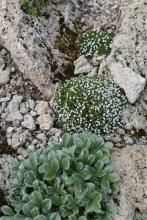
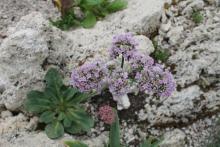
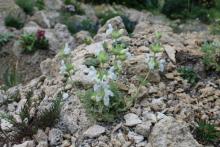
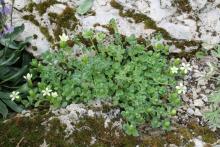
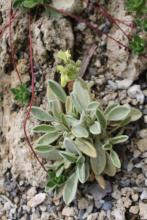
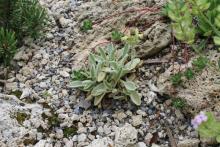
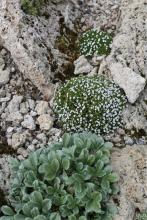
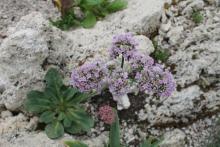




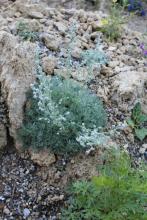
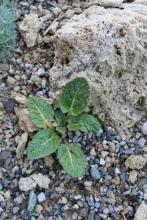
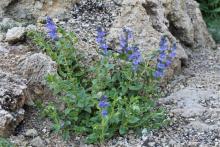
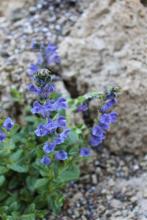
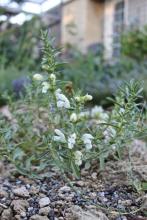
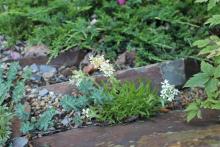
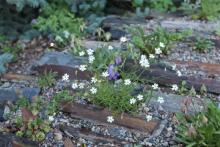
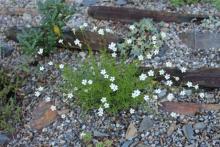
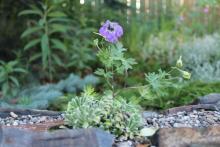
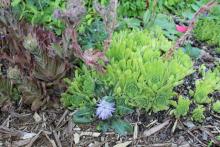
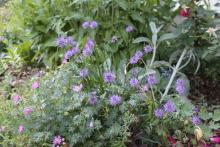
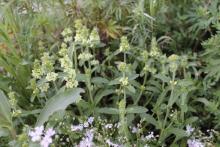
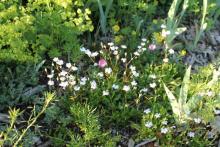

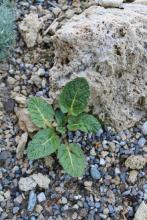
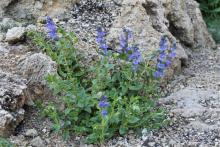









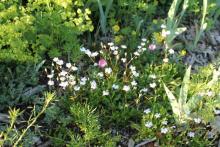
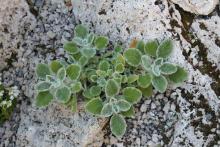

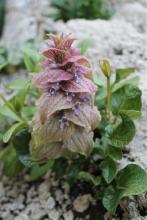
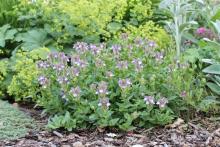
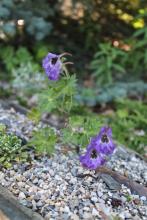
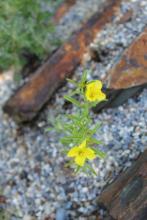
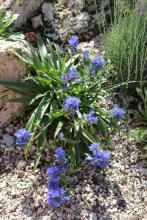
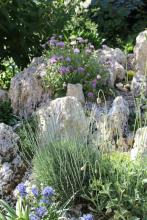
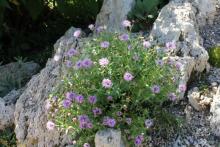
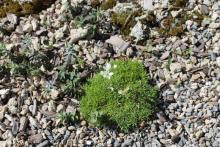








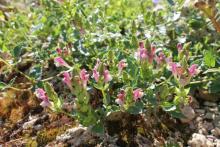
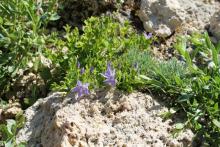
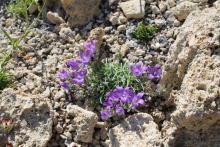



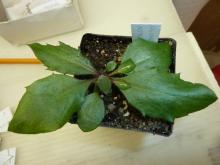
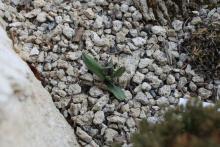
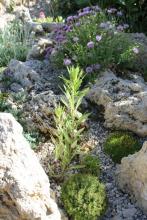
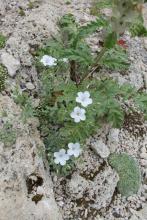
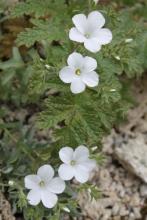
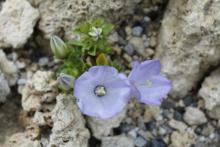
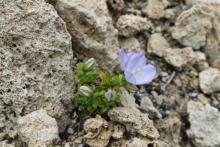
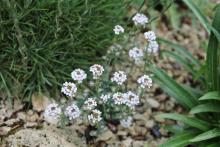
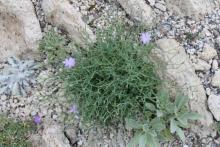
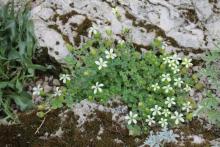
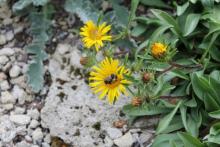












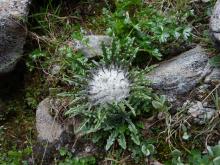
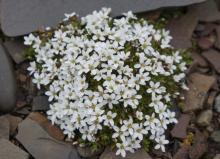
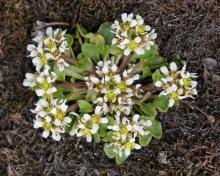

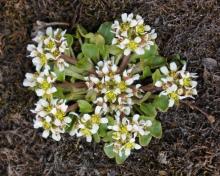
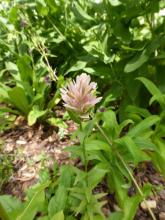
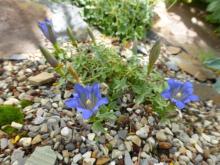
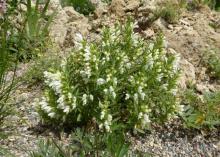
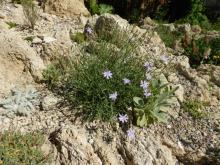
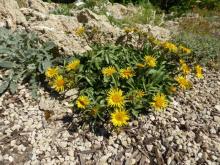


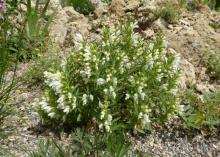
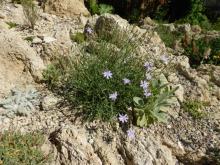
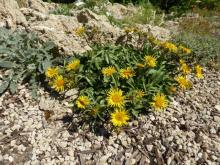
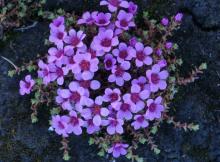
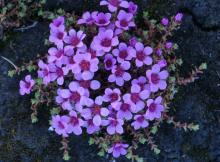
Your tufa bed is very exciting and inspiring, Lori. With all those gems!
The Goniolimon is an excellent plant! It reminds me of Limonium vulgare which grows not far from our summer house (the only known locality in Norway). But it flowers later in the summer. (Pictures from a previous year.)
I am inspired to start my own version of a tufa bed but my attempt this spring was delayed due to the frozen soil and very late thawing.